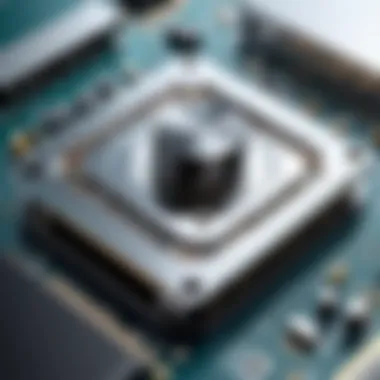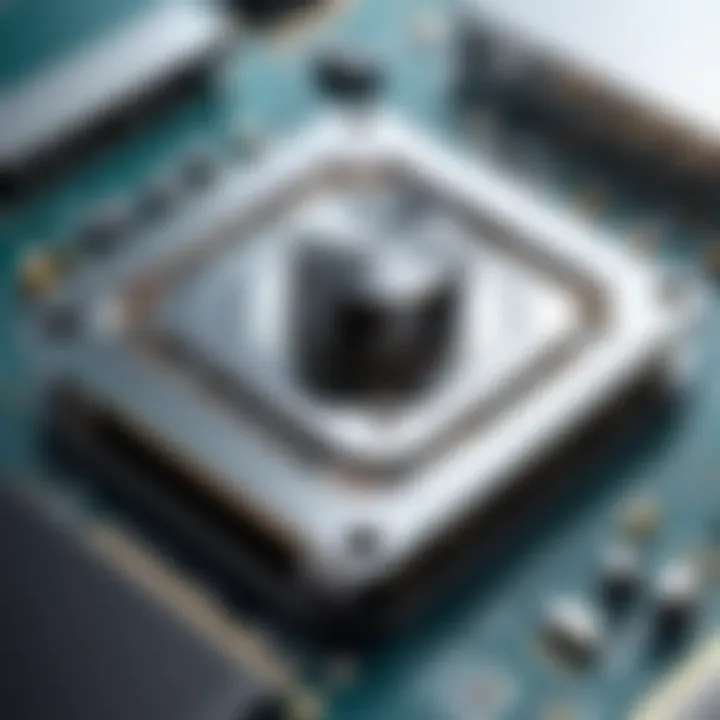Choosing the Best Desktop for CAD Programs


Intro
In today's fast-paced engineering and design environments, the importance of a powerful desktop system for CAD (Computer-Aided Design) programs cannot be overstated. As software becomes increasingly resource-intensive, the need for robust hardware to meet demanding performance standards has soared. For those engaged in architectural design, mechanical engineering, or any CAD-related activity, selecting the optimal desktop tailored to specific requirements is paramount.
Understanding the key features that contribute to an efficient workflow can make a significant difference. The performance and reliability of the desktop can effectively influence productivity, creativity, and overall job satisfaction. As we delve into the details, this guide will provide insights into hardware specifications, user experiences, and the myriad of software compatibility considerations one must navigate.
By equipping yourself with this knowledge, you'll be on your way to enhancing your design capabilities, whether you're a fledgling student or a seasoned professional. Buckle up as we explore the crucial elements involved in making an informed decision that can elevate your projects and fulfill your aspirations.
Preface to CAD Programs
Computer-Aided Design (CAD) stems from a need to enhance precision and efficiency in the design process. Whether in architectural, engineering, or manufacturing fields, CAD programs have transformed how professionals conceptualize, design, and produce objects. In this segment, we will explore why understanding CAD programs is essential for anyone looking to select the right desktop setup that caters to their specific needs.
CAD software is not just a tool; it's a fundamental part of today’s design and engineering ecosystems. As projects grow in complexity, the demand for responsive and capable hardware increases. This conversation is not solely about having the latest technology; it’s about finding the most suitable technology that harmonizes with an individual’s workflows and requirements. The balance between performance and budget is crucial and must be approached with thoughtfulness.
In this guide, we'll break down the intricacies of CAD and highlight how selecting an optimal desktop can significantly impact productivity and output quality.
Understanding Computer-Aided Design
Computer-Aided Design encompasses a range of software applications that enable users to create detailed two-dimensional drawings and three-dimensional models. The primary goal of these programs is to boost the design efficiency.
While CAD systems were once largely limited to the realms of engineering and architecture, their applications have now proliferated into a variety of fields, including automotive, aerospace, and even fashion design. The core principle remains the same: to provide designers with tools that enhance their ability to visualize and manipulate their designs with precision. The sophistication of CAD tools varies widely, from basic drafting solutions to advanced systems capable of simulating real-world physics.
Real-time rendering, parametric modeling, and even cloud capabilities are now common in many CAD solutions. This evolution is propelling the need for robust desktop systems that can handle the increasing demands of modern CAD applications. A thorough understanding of these tools is a prerequisite for optimizing workflow and ensuring that the hardware and software complement each other effectively.
Applications of CAD in Various Fields
The reach of CAD technologies is impressively diverse. Below are some fields where CAD is utilized effectively:
- Architecture: Architects rely on CAD software to produce intricate plans and visualizations for buildings. Programs like Revit and AutoCAD allow them to draft, model, and present their designs in a coherent and painstakingly accurate manner.
- Engineering: Different branches of engineering—mechanical, civil, and electrical—employ specialized CAD software tailored to their unique requirements. For instance, SolidWorks enables mechanical engineers to create 3D models and simulate their performance under various conditions.
- Manufacturing: CAD is integral in creating prototypes, simulations, and defining manufacturing processes. It's common for manufacturers to use CAD along with Computer Numerical Control (CNC) machines for creating parts.
- Fashion Design: Remarkably, CAD has made its way into the fashion industry, allowing designers to create patterns, visualize clothing design, and even generate virtual fitting rooms.
In every one of these sectors, the advantages of CAD are clear: increased accuracy, reduced time in design cycles, and improved collaboration among teams. Understanding how these industries leverage CAD tools is pivotal when considering the hardware needed to support such demanding applications.
Key Hardware Specifications for CAD Desktops
In the realm of computer-aided design, the desktop you choose can significantly influence your productivity and success. The right hardware specifications are paramount, as they determine how efficiently CAD software operates and how smoothly complex tasks are handled. Given the intricate nature of design work, every component—be it a powerful CPU to process data or a robust GPU to render graphics—plays an integral role. This section will explore vital hardware specifications that should inform your choice for a CAD desktop.
Central Processing Unit (CPU)
The CPU, often referred to as the brain of the computer, is essential for executing the calculations and operations that CAD applications require. A robust CPU promises better response times, especially during intensive tasks such as modeling or simulation. Let’s break down critical aspects here.
Importance of Clock Speed
Clock speed, measured in gigahertz (GHz), reflects how many cycles a CPU can perform in a second. It’s a key determining factor in how quickly tasks are processed. A higher clock speed means faster computation, hence offering a noticeable improvement in performance with demanding applications. In CAD programs, where complex calculations take place, such as rendering 3D models, a CPU with higher clock speeds can translate into improved efficiency.
However, one must also balance clock speed with core count—more on that next.
Multi-core Processing Benefits
Multi-core processing refers to a CPU having multiple cores, allowing it to handle multiple tasks simultaneously. CAD software increasingly utilizes multi-threading, hence a CPU with several cores is beneficial. A dual-core may do the job for basic tasks, but tasks involving heavy rendering or simulations can certainly benefit from processors with four or more cores.
By employing multi-core CPUs, users can expect smoother performance and faster execution times during design sessions. The balancing act between clock speed and core numbers is crucial in choosing a CPU that aligns with CAD requirements.
Graphics Processing Unit (GPU)
When it comes to graphics rendering, the GPU takes center stage. A superior GPU defines how CAD applications run, especially when dealing with intricate visual designs or animations.
Dedicated vs Integrated Graphics
Dedicated graphics cards are separate hardware components meant solely for handling visual outputs. These chips boast their memory and processing power, making them ideal for resource-heavy applications like CAD. On the flip side, integrated graphics use the computer's main memory, which may suffice for simpler tasks but can lead to bottlenecks with high-resolution rendering.
When engaging in design projects, opting for a dedicated GPU is often the better choice, granting designers improved frame rates and smoother interactions in complex environments.
VRAM Considerations for CAD Tasks
Video RAM (VRAM) is a special type of memory used by the GPU. More VRAM generally allows for better handling of 3D graphics and numerous textures. In CAD applications, having adequate VRAM means that complex models and large scenes can be processed without lag or display issues. A higher VRAM capacity results in smoother navigations through 3D spaces, ensuring a more seamless workflow.
Memory Requirements (RAM)
Adequate RAM is vital to prevent slowdowns during design processes. CAD programs can consume substantial amounts of memory, especially when using large files that contain detailed models or significant data sets.
Minimum RAM Recommendations
As a standard, 16GB of RAM is often deemed the minimum for decent performance in CAD applications. However, professionals who frequently work with highly detailed models may find 32GB or more to be a worthwhile investment. With sufficient RAM, the computer can manage multiple applications and processes simultaneously, which is essential in fast-paced design settings.


Impact of Memory Speed on Performance
Not only the quantity of RAM is essential, but its speed—measured in megahertz (MHz)—also holds importance. Faster RAM means quicker data access, which can lead to enhanced overall system performance. As workflows evolve with heavier software demands, choosing RAM that balances size with speed becomes critical for ensuring optimal performance throughout your design work.
Storage Solutions
Where you store your data can impact how quickly you can access and retrieve CAD files. Thus, selecting the right storage solution is vital to overall system performance.
SSD vs HDD: Which is Better for CAD?
Solid State Drives (SSDs) and Hard Disk Drives (HDDs) offer different benefits. SSDs utilize flash memory, providing faster read and write speeds compared to HDDs, which rely on mechanical components. For CAD work, I highly recommend an SSD; it significantly reduces loading times and accelerates file access, allowing you to focus on design rather than waiting.
Given the demands of CAD applications, the advantages of speed with SSDs cannot be overstated, while HDDs may still serve as a good secondary storage option for large files.
RAID Configurations and Their Benefits
Implementing a RAID (Redundant Array of Independent Disks) configuration can enhance data reliability and performance. For CAD users, RAID setups may combine speed and fault tolerance, particularly with RAID 0 for performance or RAID 1 for redundancy. This option ensures that data is not only accessible at lightning speeds but also backed up mirroring for safety.
In summary, when selecting the right desktop for CAD programs, regard each hardware specification carefully. The CPU, GPU, RAM, and storage solutions collectively shape your experience and capability in computer-aided design, making them critical aspects to consider before investing.
Software Compatibility Considerations
When choosing a desktop for CAD programs, ensuring compatibility between hardware and software is paramount. The right mix not only optimizes the performance of design tasks but also enhances workflow efficiency. Users need to understand how software is directly influenced by the specifications of the hardware. Each CAD application may demand specific configurations which, if unmet, can lead to performance bottlenecks or even hinder the operation outright.
Software compatibility also holds significance in terms of future-proofing your system. As technology evolves and new features are introduced, the desktop should be able to accommodate these changes without necessitating complete overhauls. Investing time in assessing software compatibility pays dividends in stability and performance.
Popular CAD Software Packages
AutoCAD
AutoCAD stands as a hallmarker in the CAD realm, renowned for its versatility and robust set of features. One of its primary advantages is its user-friendly interface, making it approachable for both novices and seasoned professionals. The key characteristic of AutoCAD lies in its ability to handle both 2D drafting and 3D modeling effectively, allowing users to seamlessly transition between tasks.
A noteworthy feature is the AutoCAD Sheet Set Manager, which improves organization within a large project. However, the software can be demanding in terms of resource allocation—high-end hardware is recommended to harness its full capabilities, which could translate to higher costs for custom builds or top-tier models.
SolidWorks
SolidWorks has carved a niche primarily in the mechanical engineering and product design domains, noted for its parametric design capabilities. Its intuitive interface allows for quick modifications, which can be a game-changer during the design process. The key characteristic of SolidWorks is its 3D model-building approach, enabling designs to be manipulated in a context that involves real-world constraints.
The unique feature of SolidWorks is its Simulation and Analysis tools; these allow for robust testing of designs under various conditions without the need for physical prototypes, saving both time and costs. However, it demands a solid GPU to handle complex assemblies and simulations effectively, which adds another layer to budget considerations.
Revit
Revit distinguishes itself as a leader in building information modeling (BIM), especially within the architecture and construction industries. Its collaborative features stand out, facilitating multiple users to work on the same model simultaneously—a crucial benefit for larger projects. The key characteristic of Revit is its integration with various data types, allowing users to detail and manage elements like structures, systems, and materials in real time.
A unique selling point is its ability to generate construction documentation directly from the model. While this significantly enhances accuracy and reduces duplication of work, the processing requirements can be steep, compelling users to invest in high-performance desktops to take full advantage of its capabilities.
System Requirements for Leading CAD Programs
Understanding Minimum and Recommended Specs
Establishing a clear understanding of minimum versus recommended specifications is critical. Minimum specs are the baseline requirements necessary for running the software without crashing, but they often lead to frustrating performance. In contrast, recommended specs enable users to engage fully with all features of the software.
This component is beneficial as it helps users prevent costly mistakes during the purchasing process. By investing in desktops that meet or exceed these specs, users ensure a smoother and more efficient experience, reducing downtime and frustration.
Operating System Compatibility
Operating system compatibility is another vital aspect, as many CAD programs have preferences for specific operating systems. For instance, while AutoCAD runs on both Windows and macOS, SolidWorks is predominantly optimized for Windows. This factor could influence hardware selection significantly.
The unique feature here is ensuring that Windows updates do not inadvertently disrupt compatibility with your CAD software. While keeping the OS updated is essential, understanding the specific requirements and restrictions can save headaches later down the line. If users configure their setups accordingly, they maximize software performance, leading to a seamless and productive design experience.
"Selecting appropriate hardware is not merely about specifications; it’s about ensuring a harmonious relationship between software and technology for optimal design outcomes."
By paying close attention to these software compatibility considerations, users can make informed choices that align with their design goals and future needs.
Brand Comparisons for CAD Desktops
When it comes to selecting a desktop for CAD work, the brand often becomes a pivotal point of consideration. Each manufacturer brings its own strengths and weaknesses to the table, making the choice not simply about which desktop is the most powerful, but also about reliability, customer support, and the specific needs of your CAD applications. Individual brands often tackle different user demographics, from casual users to high-end professionals, and understanding these variances can make a significant difference in overall user experience.
Among the key elements to consider in brand comparisons are build quality, upgrade options, customer service reputation, and compatibility with various CAD software packages. These factors can greatly influence not only the initial investment but also the long-term performance and satisfaction you derive from your machine. Keeping all these pointers in mind will ensure your decision aligns well with your specific CAD tasks and overall goals.
Dell Workstations
Dell has carved out a solid reputation in the workstation market, particularly with its Precision line. These desktops are crafted for professionals who require robust performance and reliability in demanding environments. Dell Precision systems often come equipped with excellent cooling solutions, which is crucial during extensive rendering tasks that can push hardware to its limits.


The Dell workstations also offer significant customization options, allowing users to select components that match their specific needs. Want more RAM? No problem. Need extra storage space? You can adjust that too. This flexibility is invaluable for businesses that anticipate varying workloads.
One thing to highlight is Dell's top-notch customer support. If issues arise, having access to strong, responsive support can save not just time but also minimize downtime significantly.
HP Z Series
HP's Z series workstations have earned acclaim for their balance of performance and price. Designed specifically for professionals, these machines offer solid build quality, which can hold up well under the intense demands of CAD applications. HP typically uses energy-efficient components, helping users to maintain a lower electrical bill while ensuring the workflows remain uninterrupted.
What sets the Z series apart is its focus on graphical performance. Many models come loaded with powerful NVIDIA Quadro graphics cards, tailored for CAD and 3D modeling tasks. Additionally, HP has integrated features like remote management, making it an appealing choice for teams that operate across multiple locations.
Furthermore, HP offers a range of service options, enabling businesses to select a support program that aligns well with their needs, be it on-site support or next-day service.
Lenovo ThinkStation
Lenovo's ThinkStation line is often hailed for its workstation performance at an approachable price. These desktops are particularly favored by those working with 3D modeling or simulation tasks, thanks to their powerful CPUs and high-VRAM graphics options. One notable feature is their ISV certification, ensuring that the workstations can handle intensive software such as AutoCAD or SolidWorks without a hitch.
The ThinkStation models are also known for their highly efficient cooling systems, which is crucial for maintaining optimal performance throughout long working hours. Users can expect a wide array of upgrade options as well, extending the lifespan of their investment.
Moreover, Lenovo's warranty and service agreements are generally well-regarded, providing peace of mind for those who prioritize reliability in their work environment.
When it comes to choosing the right CAD desktop, scrutinizing the brand is essential. Each brand’s architectural choices can greatly influence your overall experience—from performance to after-sale support.
Performance Benchmarks in CAD Work
Performance benchmarks play a crucial role in the selection of desktops for CAD programs. These benchmarks provide valuable insights into how various hardware configurations handle the demanding requirements of CAD software. When you're choosing a desktop to run high-end graphic applications or simulations, understanding these benchmarks helps ensure you’re making a sound investment. Here, we dive into important elements to consider regarding these performance metrics.
Assessing Benchmark Scores
Common Benchmark Tools
Common benchmark tools are designed to evaluate the performance of computer hardware under various scenarios. Tools like SPECviewperf and Cinebench lie at the forefront of performance testing and are widely recognized in the CAD community.
What makes these tools particularly beneficial is their ability to simulate real-world conditions. For instance, SPECviewperf focuses on professional graphics performance by measuring how well a system can handle tasks reminiscent of those found in applications like AutoCAD and SolidWorks. This specificity aids in providing targeted insights into a desktop's usability for CAD work.
However, it’s important to recognize that while common benchmark tools give a snapshot of performance, they might not cover every aspect of real-world applications. So, users should consider that while these benchmarks are insightful, they should also complement them with other evaluations to get a more rounded view of performance.
Key Takeaway: Common benchmark tools are vital for making informed decisions when selecting hardware for CAD, particularly due to their targeted real-world simulations.
Interpreting Benchmark Results
Interpreting benchmark results is as important as gathering them. These scores provide a quantitative basis for how well different configurations will perform under stress, particularly in demanding CAD tasks. Once the scores are obtained from benchmark tools, the next step is to understand what those numbers actually mean. Higher scores generally indicate better performance, but it’s essential to consider the context of those figures.
A score may look impressive, but if it was achieved using outdated software or through specific settings that wouldn’t resemble everyday use, its relevance will be limited. Thus, recognizing the specific parameters under which benchmarks were conducted allows for better-informed decisions.
For example, when you see a high score in a benchmark result, consider also the thermal performance and power consumption associated with it. It's essential to have a holistic view of performance metrics to avoid pitfalls.
Real-World Performance Tests
Real-world performance tests take things a step further by simulating typical user experiences rather than controlled environments. These tests involve using the desktop in a manner that mimics actual project workflows. They provide insight not just into how speedy a workstation might feel but also its stability under prolonged use of intensive programs.
Real-world scenarios include running multiple CAD applications concurrently or working on large 3D models, allowing testers to observe how well their system holds up under pressure. They can reveal issues that benchmarks might not capture, such as thermal throttling or resource bottlenecks in multitasking scenarios.
As a result, while benchmarks give an idea of capability, real-world performance tests present a clearer picture of day-to-day usability. This dual-layered approach ensures that users don’t just know their hardware’s peak potential but also how it will fare in the grind of a typical workweek.
Upgrading Existing Desktops for CAD Support
Upgrading an existing desktop for Computer-Aided Design (CAD) support is like breathing new life into a professional’s trusty steed. Many who work with CAD software can attest that the demands of these applications can sometimes outpace what their machines can deliver. This section focuses on the importance of updates, discussing how enhancements can boost productivity, effectiveness, and overall work satisfaction.
Evaluating Upgrade Needs
Before diving headfirst into any upgrades, it’s crucial to assess the current system’s performance. This evaluation often revolves around a few specific elements:
- Performance benchmarks: Check how the current setup performs with your CAD program. Look for lag during rendering or delays in real-time visualizations.
- Software Requirements: Many CAD applications have minimum and recommended specifications. Knowing where your machine stands against these benchmarks is the first step to determining what needs an upgrade.
- User Experience: Reflect on your workflow. Is there excessive waiting time that hampers creativity? Identifying pain points helps tailor your upgrades to meet personal needs effectively.
Understanding these factors can shape your upgrade strategy significantly.
Cost-Effective Upgrades for CAD Performance
Upgrading does not always have to break the bank. A careful selection of enhancements can provide significant improvements in CAD performance without emptying your wallet. Here’s a closer look at two crucial components:
RAM Upgrades
One common aspect that often gets overlooked is RAM upgrades. Having sufficient memory is essential for running CAD programs smoothly. When you upgrade your RAM:


- You can handle larger files and multi-task with ease. This means less waiting time and more time spent on productive work.
- Key characteristic: The speed of RAM matters. Faster RAM can lead to improved performance, ensuring that data moves swiftly between the CPU and memory.
- Unique feature: Modern motherboards can support higher capacities of RAM. This means that if you’re working with complex designs, a simple upgrade can significantly reduce load times. However, there's a trade-off to consider; while more RAM is often better, it also depends on overall system architecture and the speed of the installed components.
With these points in mind, RAM upgrades present a popular choice for those looking to enhance CAD performance without an overwhelming investment.
GPU Enhancements
Another critical upgrade is GPU enhancements. The graphics processing unit plays a pivotal role in rendering images and visualizations in CAD work. When considering a GPU upgrade:
- It directly impacts rendering speeds and how detailed a model you can work on without lag.
- Key characteristic: Dedicated GPUs are specifically designed to handle complex visual tasks, outperforming integrated options considerably. They can manage multiple displays, high-resolution outputs, and intensive rendering tasks effortlessly.
- Unique feature: Graphics cards often come with their own VRAM that aids in handling graphics-heavy programs. This can lead to smoother transitions while working on large architectural models. The downside can be the initial cost, as high-performance GPUs can require a substantial investment.
"Upgrading doesn't just mean adding more. It's about making the pieces fit together seamlessly to improve the whole system's function."
Each of these points contributes to crafting a robust desktop experience tailored for CAD applications.
Cost Considerations and Budgeting for CAD Desktops
In the realm of designing with computer-aided design programs, budgets can often feel like a double-edged sword. While the pursuit of high-end hardware might tempt you to dig deeper into your pockets, it's essential to navigate this terrain thoughtfully. Every dollar spent should echo wisely in enhanced productivity rather than draining your resources in a futile quest for perfection.
When planning your investment in a CAD desktop, consider not just the initial outlay but also the long-term implications. A well-balanced budget enforces a strategic approach, enabling you to fork over cash for critical components while avoiding any extravagant impulse buys. Just like chefs in a kitchen, it's the right ingredients that yield the best results without breaking the bank.
Evaluating Cost vs Performance
Understanding the relationship between cost and performance is crucial. Many often reveal excitement over flashy specs but overlook that they do not always equate to tangible improvements in CAD tasks. Before succumbing to marketing hype, evaluate what you genuinely need.
- Identify Tasks: Are you working on intricate 3D modeling or managing simpler 2D drafts? Recognizing the complexity of your regular workload dictates the level of hardware needed.
- Set Priorities: Generally, a CPU’s processing power and a dedicated GPU are the stars of the show for CAD work. Focus your budget on these areas before splurging on other components like top-tier monitors or peripherals.
- Cost-Effectiveness: Sometimes opting for slightly older versions of processors and GPUs can help save a few bucks but still deliver the performance you need. Estimating your requirements means you don’t have to buy the latest and greatest.
Investigate benchmarks—real-world performance comparisons—to find hardware that offers the best bang for your buck. Discussions in tech forums, like on Reddit, also reveal user experiences with various setups, which can be invaluable in finding cost-effective solutions.
Budget Desktop Solutions
Finding budget desktop solutions doesn’t have to feel like searching for a needle in a haystack. Many manufacturers offer entry-level configurations designed to deliver adequate performance for CAD use without emptying your wallet. Look for models with solid build quality and reliable after-sales support.
Some notable budget desktop solutions include:
- Dell Precision 3000 Series: Provides decent processing power suitable for entry-level CAD work.
- HP Z2 Mini G4: A compact solution that doesn't skimp on performance, great for designers short on space.
- Lenovo ThinkCentre M Series: Cost-effective while equipped with vital components needed for basic CAD applications.
Always examine pre-built configurations against the cost of building your own. Sometimes piecing together a desktop can yield better specifications for a fraction of the price. However, if one chooses the DIY route, be wary of compatibility issues and ensure every component serves the intended purpose.
Future Trends in CAD Technology
The landscape of Computer-Aided Design (CAD) technology is evolving rapidly, influenced by advances in both hardware and software. Understanding these future trends is pivotal for users aiming to stay competitive in this dynamic environment. This section draws back the curtain on critical technological advancements, discussing how they can enhance performance, streamline workflows, and improve user experiences in CAD environments.
Emerging Hardware Technologies
As technology gallops forward, one of the most noticeable shifts in CAD has been in its hardware. Desktops designed specifically for CAD tasks are now integrating cutting-edge innovations that enhance processing power and efficiency.
Some notable trends include:
- AI-Optimized Processors: Future CPUs are increasingly tailored to handle complex computations, making tasks quicker and more efficient. This contrast with traditional methods brings about improvements in rendering and design simulations.
- Quantum Computing: Although still in its infancy, quantum computing offers unique opportunities in CAD. Its potential for solving complex algorithms at lightning speed could revolutionize processes in architecture and engineering.
- Virtual Reality (VR) Integration: With VR hardware becoming cheaper and more accessible, architects and designers can now walk through their designs in a fully immersive environment. This changes how projects are visualized and allows for more interactive client presentations.
- Improved Graphics Cards: The GPUs, essential for rendering, are becoming more powerful. Models now come equipped with more cores and higher bandwidth memory, supporting high-resolution displays and complex graphics smoothly.
As you consider upgrading your CAD desktop, these technologies will influence not only your work's speed but also its quality and presentation.
Software Innovations Impacting CAD
Software development for CAD processes is also making significant strides. Developers are increasingly focusing on creating tools that integrate seamlessly with the latest hardware advancements. Here are a few noteworthy innovations:
- Cloud-Based Solutions: Cloud computing continues to reshape CAD applications, allowing for greater collaborative efforts. Teams can share, edit, and manage designs from various locations in real time, breaking geographical constraints.
- Artificial Intelligence in Design: Machine learning is being employed to predict user behavior and streamline repetitive tasks within CAD software. For instance, AI algorithms can suggest design improvements or automate tedious elements of modeling, thus freeing up valuable time for creative tasks.
- Enhanced Simulation Tools: Modern CAD programs are now able to simulate real-world conditions more accurately. This means engineers can better predict the performance of their designs before they are physically created, saving resources and time.
- Interoperability Improvements: As industries often use different CAD systems, future innovations focus on enhancing interoperability among various software. This will facilitate smoother transitions and data exchanges between platforms, minimizing the frustration that comes from format incompatibilities.
In summary: Embracing these software advancements not only enhances individual productivity but also pushes the boundaries of what can be achieved in design projects.
End and Recommendations
As we wrap our exploration of CAD desktops, it’s crucial to reflect on the insights gained and how they pertain to your journey in computer-aided design. The landscape of CAD technology is not just about hardware specifications but a holistic approach that considers your unique needs, industry expectations, and future aspirations. Having a tailored solution for CAD work is essential because the efficiency and productivity of your design processes can hinge on the right equipment. Choosing wisely can mean the difference between frustration and a smooth workflow.
Recap of Key Considerations
To streamline your decision-making process, let’s revisit some pivotal points discussed throughout the article:
- Hardware Specifications: Prioritize components like a capable CPU and GPU. For heavy tasks, a multi-core CPU paired with a robust graphics card can significantly enhance performance.
- Memory and Storage: Aim for at least 16GB of RAM for average tasks, while 32GB or more is advisable for intricate designs. Opt for SSDs over HDDs due to their speed, which is a game-changer in loading times and overall responsiveness.
- Compatibility: Ensure your desktop meets the system requirements of your preferred CAD software — compatibility can save you from future headaches.
- Budgeting: Understand the balance between cost and performance. Sometimes, spending a bit more initially can pay off in longevity and efficiency, especially for serious professionals.
By keeping these elements in mind, you can better navigate the sea of options available, making an informed decision that aligns with your design goals.
Final Thoughts on Selecting the Best Desktop for CAD
Selecting a desktop for CAD work can feel overwhelming, given the multitude of choices and nuances involved. However, by focusing on your specific demands and industry developments, you can carve out a path that not only meets your needs but anticipates future challenges.
Investing in the right desktop is about foresight; it's not just about what's needed today but what will be required tomorrow. As technology progresses, you may find your projects growing in complexity, thus elevating the importance of a sound machine that can seamlessly handle demands without lag or crashes.
"In the world of CAD, the right tools do not just create; they innovate and inspire. Choose wisely."
By carefully weighing all aspects discussed, you’ll be well on your way to identifying a desktop suited for CAD programs that not only meets expectations but exceeds them.







